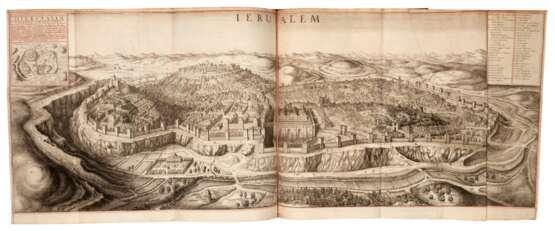ID 1073287
Lot 9 | Bible, English, King James Version | Cambridge, 1660, 2 volumes, numerous engraved illustrations
Estimate value
£ 7 000 – 10 000
The Holy Bible [and] The Book of Common Prayer. Cambridge: Printed by John Field, 1660 [New Testament dated 1659]
2 volumes, folio (435 x 290mm.), the Apocrypha and New Testament bound following the Book of Common Prayer in volume 2, text in double columns, ruled in red, woodcut headpieces, tailpieces, and decorative initials, title pages with decorative border and small printer’s device, engraved frontispiece of the King’s Arms, ELABORATELY ENGRAVED TITLE PAGE OF SOLOMON ENTHRONED, A FOUR-PAGE FOLDING PLATE OF JERUSALEM, AND 109 DOUBLE-PAGE PLATES (including a four-panel map of the Holy Land as well as 3 double-page plates of Solomon’s Temple), recent red morocco elaborately gilt in period style, first few leaves of volume 1 with repairs at bottom corner, title page with a few square inches added, either from another copy or in manuscript, dedication page with loss of printer’s last name, one folding plate with tip of lower right corner repaired (no loss), title page of Common Prayer a little soiled
This large, magnificently illustrated Bible is the creation of John Ogilby (1600-76), the Scottish miscellaneous writer whose name is attached to so many collectible illustrated folio editions of classical and geographical works. As ODNB indicates, Ogilby, “with the assistance of Dr John Worthington and other divines… brought out at Cambridge in 1660 a noble edition of the Bible (two vols. royal folio), illustrated with ‘chorographical sculps’ by Ogilby himself, and 107 engravings by Dutch Golden Age engraver Cornelis Visscher (1629-1658), after Rubens, de Vos, de Bruyn, Tintoretto and others. Having presented a splendidly bound copy of it to the king on his first coming to the royal chapel at Whitehall, he was commanded to supply other copies for use in the chapel, closet, library, and council chamber, at a cost of £200. He presented another copy to the House of Commons, for which he received £50”. Presumably flushed with such acceptance and monetary success, “he petitioned the king to prohibit anyone for 10 years from printing a folio Bible such as his, and to commend his edition to all churches and chapels, that he might thereby be encouraged in his design of printing a polyglot Bible”. He was apparently persuasive, because, according to Wing, the next folio Bible to be printed in England did not appear until 1674. This Bible would not have enjoyed wide use, however, because its size would very likely have confined its serviceability primarily to the church or chapel lectern. Pepys comments in his diary on 27 May 1667 that he was approached by a bookbinder with quires
of Ogilby’s Bible, and although Pepys seems resigned to buying the set, he comments that “it is like to be so big that I shall not use it”.
| Auction house category: | Prints, graphics, books |
|---|
| Auction house category: | Prints, graphics, books |
|---|
| Address of auction |
Sotheby´s 34-35 New Bond Street W1A 2AA London United Kingdom | |
|---|---|---|
| Preview |
| |
| Phone | +44 (0) 20 7293 5000 | |
| Phone | +1 212 606 7000 | |
| Conditions of purchase | Conditions of purchase |





